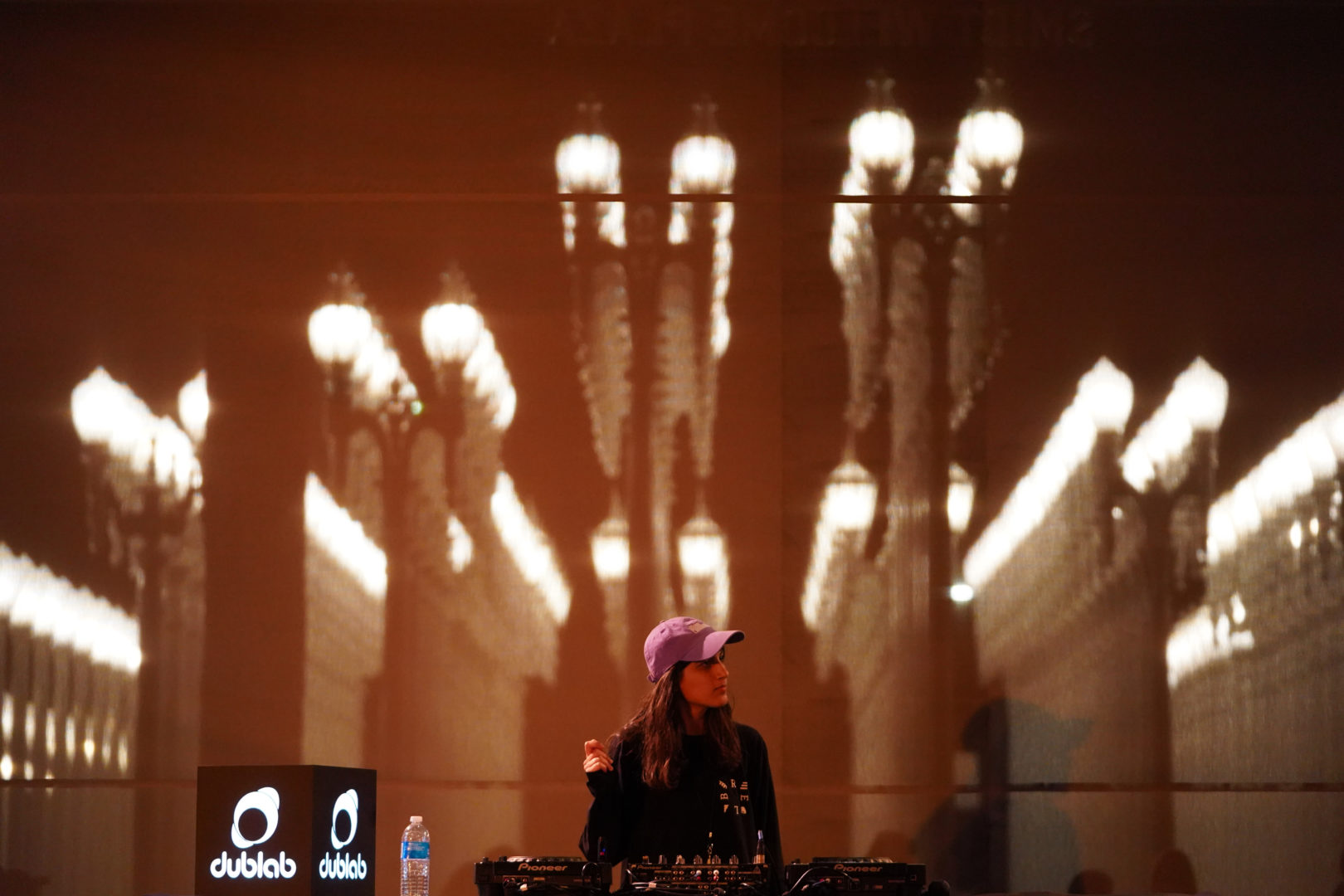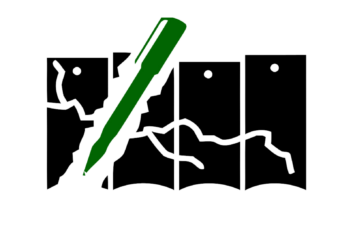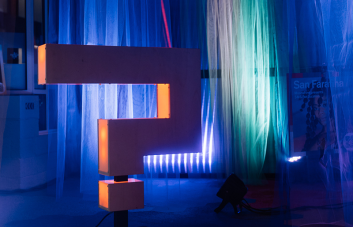 It’s been over a year since we last spoke to Maral, the LA artist whose distorted rhythms have captured the attention of international artists, renowned journalists, and notable music platforms alike. In the time since, Maral has performed numerous live sets, DJ’d radio shows, hosted local parties, participated in Red Bull Music Academy’s Bass Camp, created tracks for various artist compilations, and most notably, released a tape on Astral Plane Recordings, titled Mahur Club. The release is an extension of her mix ‘Voices from the Land of Iran’, which was featured on Truants last March and predominantly samples an anthology album she found at a store in LA’s Persian Square, along with tracks she’s created over the past several years while honing her highly particular sound. “There’s this one music store that sells CDs and tapes, and I noticed a bunch of the stores around it were closing and got scared that it would go out of business, so I decided to go in and buy some CDs and luckily stumbled across this one! I really worry about the possibility of these old melodies and musical traditions disappearing from the collective conscious, and am very interested in what we can do to keep passing them along.”
It’s been over a year since we last spoke to Maral, the LA artist whose distorted rhythms have captured the attention of international artists, renowned journalists, and notable music platforms alike. In the time since, Maral has performed numerous live sets, DJ’d radio shows, hosted local parties, participated in Red Bull Music Academy’s Bass Camp, created tracks for various artist compilations, and most notably, released a tape on Astral Plane Recordings, titled Mahur Club. The release is an extension of her mix ‘Voices from the Land of Iran’, which was featured on Truants last March and predominantly samples an anthology album she found at a store in LA’s Persian Square, along with tracks she’s created over the past several years while honing her highly particular sound. “There’s this one music store that sells CDs and tapes, and I noticed a bunch of the stores around it were closing and got scared that it would go out of business, so I decided to go in and buy some CDs and luckily stumbled across this one! I really worry about the possibility of these old melodies and musical traditions disappearing from the collective conscious, and am very interested in what we can do to keep passing them along.”
Both texturally layered and visceral in sound, Mahur Club churns with emotion; a heartfelt expression of Maral’s relationship with Iran. She describes treating samples as distinct voices in the midst of conversation, “like walking through certain areas in Iran and hearing all the voices passing by, and music from peoples cars, or street musicians, or the mosque that you pass.” Distortion presides strongly over the release, an effect the artist uses to “channel sadness and frustration with everything that is happening with Iran.” At times the music feels strained, as if the distortion is tearing it apart at the seams. Over the course of the tape, Maral distorts elements of folk, dub, punk, classical, pop, jersey club, reggaeton and electronic, into an experimental sound collage that shifts unpredictably. Warped and wonderful, Maral’s Mahur Club is like a distant dream that can’t be articulated, yet remains a powerful vision inseparable from memory.
As a follow up to our previous interview where we introduced the artist and her sound, we wanted to discuss Maral’s new release in more detail, focusing on the work’s themes and influences. In the interview below, we highlight her musical inspirations, the role of improvisation in her work, and her experiences with Persian art and culture, along with photos and references provided by the artist.
Hi, Maral! It’s really cool to catch up again and talk about the new release. How are you doing, and what have you been up to lately?! “So happy to get a chance to chat together about the release :) I’m doing good–one thing I’m really stoked about is that I just got accepted into this film residency at Echo Park Film Center, which is an amazing non-profit media arts organisation committed to providing equal and affordable community access to film/video resources. Excited to finally learn how to use something beyond iMovie haha.”

Have you since returned to the store where you purchased Voices from the Land of Iran? Do you visit the Persian Square often, and if so, have you seen any changes or store closings that previously worried you? Do you get the opportunity to interact with many other people of Iranian heritage in LA? “I actually went recently when my dad was visiting! I took him to the music store and he ended up having an in-depth discussion about music with the store owner who has been there for over 30 years. They talked about the changes in Persian music once it came over to Los Angeles, and argued about which CD I should get, haha. They kept recommending more professional, newer recordings of Persian classical music, and I was looking more for regional, old music. The owner was kind of perplexed with that which was funny. It was really great getting to hear his take on the evolution of Iranian music and I get anxious about knowledge like that disappearing. Already there are more and more shops being closed on that strip. In LA, I have met some really amazing Iranians who are also taking their heritage and recontextualizing it through film or music.”
What inspired the addition of the Jersey club sounds in your music? I remember you experimenting with so many different sounds back in high school, but I feel like we talked a lot less about genres then. “I got into Jersey Club in 2014 through UNIIQU3’s awesome mixtape, “The New Klassiks”, and her TINASHE remix. I’m obsessed with all the different ways its grown, from the distorted raw sounds of Dollarboyz to how it’s been incorporated into experimental electronic music. I started slowing down jersey club beats to around 60-100bpm and adding Iranian songs on top. That ended up sounding too somber to play at the club, so I started messing around with them at the correct BPM and that’s how something like Mahur Club came about–where it samples a track by the amazing A.B.E and I add sounds from the setar and this live performance by Hayedeh for Persian New Year.”
What was your most valuable experience from Red Bull Music Academy’s Bass Camp? Was this your first time collaborating with others on electronic music? “I always talk about how getting to have those five days dedicated to making music, having access to studios, and getting to actually work and talk to others working in experimental music was the most music life changing experience for me! It was the first time I felt like I could be a “producer.” Everyone was so encouraging and I learned a lot more about music production by just watching others produce. I ended up taking that knowledge and using it to make a bunch of the tracks on the mixtape. Seeing how someone made a beat in Ableton, I was like oh damn that’s not as hard as I thought it was going to be. It was a really special crew of people, who were so supportive and inspiring. Everyone was working on music from the moment we woke up ’til 5am. I had never had that experience, and felt such a growth from it all.”
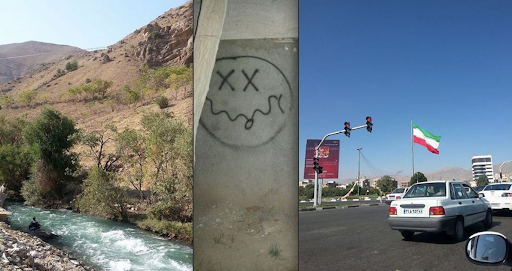 What are some of your favourite visual memories from Iran? You’ve mentioned treating the tracks as walking through different sites around Iran—were there any particular places you had in mind? “Visuals from Iran pop into my head almost every day. I think a lot about how it felt to walk down an empty neighbourhood street in the afternoon when everyone is taking naps and the stores are closed, how the sounds of the prayer calls from the mosque start waking everything up. We would drive into the mountains a lot to get to this river, and that drive really influenced the music, as well as driving through the city at night with the trees lit up by lights, and all the sounds coming in and out of the packed car. I try to convey those feelings through the experimental videos I make using found footage.”
What are some of your favourite visual memories from Iran? You’ve mentioned treating the tracks as walking through different sites around Iran—were there any particular places you had in mind? “Visuals from Iran pop into my head almost every day. I think a lot about how it felt to walk down an empty neighbourhood street in the afternoon when everyone is taking naps and the stores are closed, how the sounds of the prayer calls from the mosque start waking everything up. We would drive into the mountains a lot to get to this river, and that drive really influenced the music, as well as driving through the city at night with the trees lit up by lights, and all the sounds coming in and out of the packed car. I try to convey those feelings through the experimental videos I make using found footage.”
I love the videos you created for the tracks on Mahur Club–they just seem like the perfect reflection of your style. Why did you decide to create them, and did you pull from any particular visual references? “I created them as a way to share the songs–usually whenever I made a track that I dug I would quickly make a ‘lil video in iMovie to go along with it to try to convey the visual aspect of the music–since the songs feel like ‘lil visual journeys. I wanted the videos to capture the feelings I had driving/walking through Iran–the chaos as well as the poetry of it all. I also wanted to pay homage to the areas in Iran that the samples are from, so I used found footage from different regions in Iran that the samples are from like the Lorestan province.”
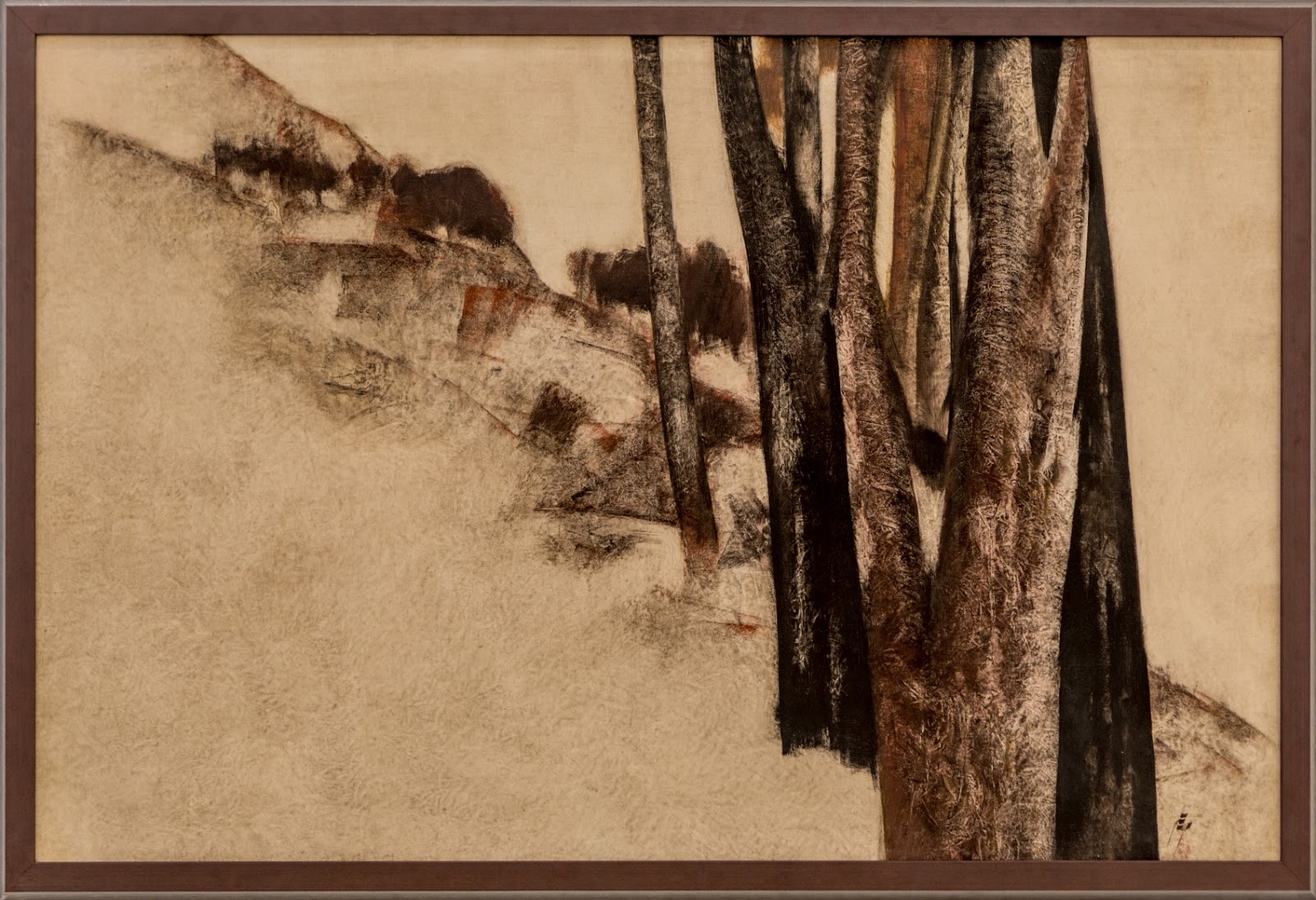
You’ve mentioned that TV shows playing nature videos with soothing music was commonplace in Iran. Do you feel that the culture has a strong connection to and appreciation of nature? Many of the Iranian holidays seem to revolve around the seasons, and I’ve always found that really beautiful and meaningful. “Yes, that is my favorite aspect of Iranian culture. I love that it’s roots are so ancient and that this focus on nature has still survived to this day! It feels really settling to have rituals and traditions based on the seasons, to be reminded that we are a part of nature too. Also so much of Persian poetry and music is based in nature. One of my favorite poets and artists, Sohrab Sepehri, I feel like epitomizes the Iranian love for nature, where he is in awe of it all but also there is a melancholy. I feel like that feeling of awe and melancholy is at the heart of being Iranian. I even felt that watching those nature shows, with the beautiful images set against the somber Persian classical music.”
Did the influence of the punk aesthetic in your approach to production originate from living in Iran or the US? What are some of the elements of punk that attract you most? “I think sonically it originated in the US, ’cause that’s where I had access to explore so many different sounds through the internet. I remember using Soulseek in high school and going through people’s music folders and finding all this anarcho-punk. Crass was the band that had the biggest impact on me because they seemed to go deeper than other punk bands and didn’t fall into the commercialization of it. I really liked that they were a band that was against the “cult of personality” which was a big part of so many bands back then and now. They had such a strong ethos and philosophy that really shaped me, as well as the way they approached sound. I feel like they were my first introduction to experimental music, the way they added found sounds and warped distortion. I think their use of distortion really influenced the way I use it in the mixtape. They taught me so much through their music and their label. I still get inspired when I listen to them.”
You’ve described the use of distortion as a way to express your emotions. When you listen back to your own music and hear the heavy distortion, are you reminded of the anger or sadness you felt in the moment while creating it? “I definitely use distortion as a way to express my emotions, and I’m usually not an angry person. For so long, I felt like I would substitute sadness for anger, but as I’ve grown older, the anger is becoming more prevalent as I see how unnecessary so much of the bad in the world is. Some of the tracks on the tape are from 10 years ago, when the distortion was representing more of a sadness about the world, and I’m sampling sad Persian music combined with slowed down Moombahton beats haha. I also used to sample a lot of Patsy Cline. I feel like she was so good at conveying that same type of sadness that someone like Hayedeh did. Now with the more recent songs on the mixtape, the ones that sample the field recordings of these raw folk songs, that distortion feels more angry to me–although there is still that deep seated melancholy that I really do think most Iranians deal with. It feels more like Crass distortion to me, where it’s like “what the fuck, this needs to change,” and being angry that so many people are complacent to the bad in the world, whether it be the way the music industry is run, how social media has warped everything into brand/product mindset, and how everyone just plays into it. Or the more global aspect of how our votes in America affect so many others out there in the world. I could go on and on :(“
Your intuitive approach to music appears to lead to a lot of collaging and trial and error when producing. Do you ever second guess your decision making, or is this a process you can trust? “Hmm, I get bummed sometimes when an idea I have in my head doesn’t click ’cause that’s really what I’m trusting in, whether this combination I want to try out will click or not, and that’s really beyond me. My favorite is when I’m just playing around and picking things at random and it just clicks, and becomes something beyond what I could have calculated. Like I always say, I don’t really know how to produce in the typical way, I’m learning more every day and do want to get to a point where I can make some of my more grand ideas come to life, but for now I love the process I have of letting the sounds lead the way and just trying to find the gems.”
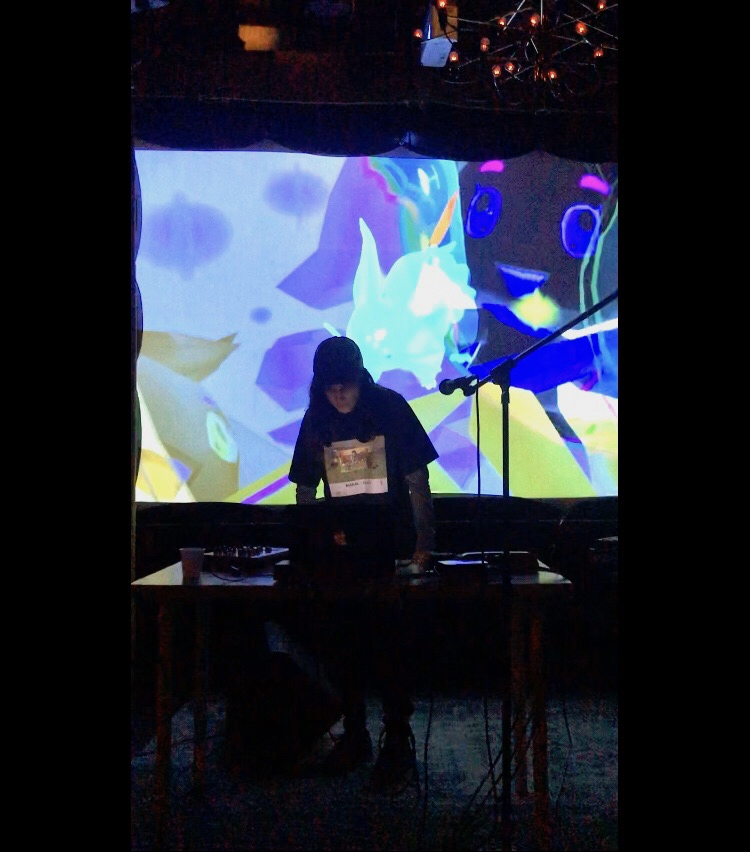 How much planning goes into your live sets? Are you more drawn to improvisation? “There is definitely a bit of planning that goes into it all since I don’t use headphones and really love figuring out cool transitions. After I figure out the base of it, I then improvise within it. Usually what happens is that I end up changing a lot of it based on the environment. For example, the tape features a live set I did where I ended up improvising most of it ’cause the set was longer than what I had planned! I had all these elements and sounds I knew well–so I just had fun with playing around with those and falling into a more meditative state with it all than I would usually. I do really love improvisation and it is a big part of Persian classical music, so I’ve always seen it as a way to go beyond the notes and make something your own.”
How much planning goes into your live sets? Are you more drawn to improvisation? “There is definitely a bit of planning that goes into it all since I don’t use headphones and really love figuring out cool transitions. After I figure out the base of it, I then improvise within it. Usually what happens is that I end up changing a lot of it based on the environment. For example, the tape features a live set I did where I ended up improvising most of it ’cause the set was longer than what I had planned! I had all these elements and sounds I knew well–so I just had fun with playing around with those and falling into a more meditative state with it all than I would usually. I do really love improvisation and it is a big part of Persian classical music, so I’ve always seen it as a way to go beyond the notes and make something your own.”
I wasn’t aware that improvisation was a major part of classical Persian music. That seems to break against typical norms of classical music, no? Could you elaborate on this a bit? “Yeah, it seems a lot less rigid to me than western classical music. In Persian classical music, you memorize the ancient repertoire that’s been passed down by the masters and then there is an emphasis on playing that repertoire in your own way, transcending the notes.
8.1 Improvisation types
There are two improvisation types: the big improvisation and small improvisation. The big improvisation includes spontaneous innovation of the Gushehs (the 365 central nuclear melodies) and it needs a very rare skill and inspiration. The small improvisation includes some changes in the embellishments or rhythm but limited in the structure. (Safvat 2009, 153)
Lotfi is my favorite master of Persian classical music because he improvised and played the classical instruments like the setar and tar in a different way than his predecessors.”
 I remember your dad’s office having a whole collection of tapes—do you ever revisit or sample that material? Would you say that your family has influenced your musical taste? How has your family responded to your music? “Aw yeah, I loved going through that tape collection and used to always listen to my parents tapes and CDs when I was younger. The last time I went to Iran, I took all the tapes that we had there and brought them back and made a mix out of them for NTS last year. Some of the tapes were so old that they were warped in the coolest ways, so that was really fun to explore, and there were mixtapes with all this Kurdish music that I hadn’t heard of. My family has definitely influenced my musical taste. No one in my immediate family plays music themselves but everyone really loves it and feels it. My dad is friends with some amazing musicians and I got to study the setar with one of his friends in high school. My family really liked it when I played the setar and that I was getting more interested in classical music and spreading the sounds through my dj mixes. As for my own experimental productions, they are proud that I’m continuing to spread Iranian music and culture, but I think some of it is too dark and distorted for their taste. I get shy about showing it to them.”
I remember your dad’s office having a whole collection of tapes—do you ever revisit or sample that material? Would you say that your family has influenced your musical taste? How has your family responded to your music? “Aw yeah, I loved going through that tape collection and used to always listen to my parents tapes and CDs when I was younger. The last time I went to Iran, I took all the tapes that we had there and brought them back and made a mix out of them for NTS last year. Some of the tapes were so old that they were warped in the coolest ways, so that was really fun to explore, and there were mixtapes with all this Kurdish music that I hadn’t heard of. My family has definitely influenced my musical taste. No one in my immediate family plays music themselves but everyone really loves it and feels it. My dad is friends with some amazing musicians and I got to study the setar with one of his friends in high school. My family really liked it when I played the setar and that I was getting more interested in classical music and spreading the sounds through my dj mixes. As for my own experimental productions, they are proud that I’m continuing to spread Iranian music and culture, but I think some of it is too dark and distorted for their taste. I get shy about showing it to them.”
Ah, that’s really interesting about the setar, because I clearly remember you going to lessons, but I guess I always assumed someone else in your family played the instrument. That’s really cool that you both had the opportunity and the interest in learning! “<3”
Could you talk about the role of dub in your music? I remember listening to so much King Tubby with you in the past, and I definitely feel that spaciousness with the resounding vocals in your music. “I became really obsessed with dub music in college, after learning about it through the liner notes in Panda Bear’s Person Pitch where he shouted out Lee Scratch Perry. It was such a sweet time getting to drive around blasting dub music and having everything feel so new. What really excited me about it was how they took a song that already existed and made it into this otherworldly, completely new thing–how you didn’t need to be a proper musician to make it, and it seemed to me one of the free types of music. I am also so damn obsessed with delay; how the dub producers used delay seemed really spiritual to me, and that has influenced how I use delay a lot as well.”
Ah, yes! Lee Scratch Perry! How could I forget? Reminds me of that summer we spent weeks just hanging out on my front porch haha. But yes, didn’t Panda Bear sample Lee Scratch Perry in ‘Carrots’? Also, I wanted to ask you about one of your samples on the tape, the line that says, “asking for peace but they never stop fighting.” It really stood out to me and just would love to know more about why you selected it. “I love that part in ‘Carrots’! I’m glad that line stood out to you. It samples the track ‘Sixth Dangerous Match’ by another dub pioneer, Scientist. I wanted to start the B side of the tape with this sentiment of how the song starts with saying “we should all start uniting” but then he says “asking for peace but they never stop fighting” and then I mix it into this evil type of beat, representing how so many of us want peace and good for others, but even with that, the minority of evil people take over the world and ruin it. It’s just so overwhelming how we have the tools to make it better but aren’t allowed to basically.”
I know Animal Collective has been a major inspiration for you over the years. In what ways have their production methods worked their way into your own process? What aspects of their music influence you most? What song of theirs would you say most closely represents your own approach to music? “I feel so lucky to have discovered Animal Collective when I did, because they also have this approach to music-making that seems spiritual and free. Each album is an exploration of sound but also they make these amazing catchy songs. I think I’m most influenced by live Animal Collective. I used to collect bootlegs of their shows and loved how they would play different versions of their songs live. You could see them two nights in a row with almost the same set list and have it be wildly different. The way Panda Bear used samples made me feel more comfortable making weird jams out of samples. I think they really know how to combine the experimental and accessible in a way no one else can or has. I think the earlier Animal Collective stuff represents my approach to music making more, like Danse Manatee is the album that I think I was the most influenced by. But in terms of a song, I always go back to ‘For Reverend Green’ as an influence, which I finally got to see live for the first time this year!”
‘For Reverend Green’ might be my favorite Animal Collective song actually. The way Avey Tare sings so erratically from his chest like he’s on the verge of exploding…and the lyrics’ visual references have always really resonated with me. “I love the sample it starts out with, and how it gets engulfed by the rest of the song. It’s a sample from a CD of bigfoot sounds lol. I used to really love hunting down what the samples were in their songs, and it’s wild the way they warp them into almost unrecognizable sounds.”
 What do you love about living in LA? You’ve been very involved in the music scene since moving there several years ago—how has it changed and in what ways do you want to see it grow? Do you have a favorite party or venue there? “I love the diversity in LA, from different cultures to the different music scenes. The music scene is filled with many dedicated and compassionate people who work so hard to keep the scene going–especially the underground music scene. I had to take a break from djing four years ago because of some health issues. I was also getting frustrated playing in certain bar environments because of the weird sexual harassment that happened so casually. It was because of some really amazing people in the scene who created spaces that allowed me to play my weird experimental music/dj sets that I was able to get back into it! I think the underground music scene has been growing every year into an even more positive and nurturing scene. One of my biggest dreams is for the underground electronic scene to have more access to resources and safe venues. I want us to be able to play the same venues as indie bands and have the same access to amazing sound systems and safety that other genres of music have.
What do you love about living in LA? You’ve been very involved in the music scene since moving there several years ago—how has it changed and in what ways do you want to see it grow? Do you have a favorite party or venue there? “I love the diversity in LA, from different cultures to the different music scenes. The music scene is filled with many dedicated and compassionate people who work so hard to keep the scene going–especially the underground music scene. I had to take a break from djing four years ago because of some health issues. I was also getting frustrated playing in certain bar environments because of the weird sexual harassment that happened so casually. It was because of some really amazing people in the scene who created spaces that allowed me to play my weird experimental music/dj sets that I was able to get back into it! I think the underground music scene has been growing every year into an even more positive and nurturing scene. One of my biggest dreams is for the underground electronic scene to have more access to resources and safe venues. I want us to be able to play the same venues as indie bands and have the same access to amazing sound systems and safety that other genres of music have.
There are so many amazing parties in LA. The ones that have influenced me a lot the past years have been Cameo, which was the party that reintroduced me to the scene and I met some really amazing people there; and Discostan, founded by Arshia Haq, who has influenced me greatly with her field recording and curatorial work. I even sample a part of one of her sound collages on the Mahur Club tape. Directory is another party that has been so supportive and open to experimentation; Minty Boi and Weed Rave also work hard to bring all different sounds to the scene; and Late Night Laggers and Rail Up have been really influential to me as well! Definitely need to shout out Kathy Suarez (Helikonia) and Stryker Matthews who are not only putting on rad parties at the Ace Rooftop, but are such genuine supporters of the scene and work hard to help others.”
Who are some other artists that excite you? Any other artists that have majorly influenced you? If you could work with any other producer, who would it be and why? “I’m very excited by the current music ecosystem. I’m always most excited by the underground experimental electronic scene but have been listening to more band music recently. I really want to start a band, lol, but it’s so hard to find the time to work with others. I’ve met so many awesome musicians and producers in LA and really want to find the time to be able to collaborate more. I try to highlight all the amazing new music and artists on my dublab show.
David Lynch is someone who has super influenced me–his films and music. He is so genuinely himself in this magical way and you feel that in his work. Also Jan Svankmajer’s films and sound design have always stayed with me. Both him and David Lynch have impacted how I see and hear things. My Bloody Valentine was such an influential band for me and there are some tracks on the tape where it’s just me wishing I was My Bloody Valentine haha. I think making a track with Grouper using the setar would be really rad–she’s another artist that is uniquely themselves and it shines into the music.”
What’s next for you in music? Are you actively producing or working on new live sets? “I am! I’m playing a lot more live shows which has been so awesome–getting to hear the tracks on a banging sound system helps you think about the music you make in a different way. I also just finished up a couple of remixes for people who have influenced me greatly, which is wild. I really want to work more in actual studios and make some of my wilder ideas become reality!”
Maral: Bandcamp, Facebook, Instagram, Soundcloud, Twitter
Mahur Club is out now on Astral Plane Recordings, available here.
Photos courtesy of the artist and Diana Rojas.

